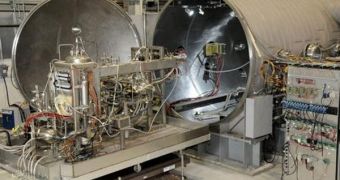Even before three independent spacecraft confirmed the existence of water-ice on the Moon, the American space agency, NASA, had plans of someday going to the lunar surface and establishing a permanent research base there. In order to make this a reality, a sustainable, durable, compact and light-weight power source was needed, and nuclear power was the first on the list of options. However, mounting a nuclear reactor on the natural satellite was considered impossible, so scientists proceeded to miniaturize the devices, until they brought them down to the size of a trash can.
In the past years, three separate studies that have taken place at different NASA research centers and at a national laboratory in the US have demonstrated what officials have termed “key technologies” for the development of compact, nuclear fission-based reactors, suitable for space explorations, and off-world settlements. “The recent tests bear out that Fission surface power system could be an important source of energy for exploration on the Moon and Mars. This power system could provide an abundant source of reliable, cost-effective energy and may be used anywhere on the lunar surface,” Project Manager for Nuclear Systems Mike Houts, from the Marshall Space Flight Center, in Huntsville, Alabama, says.
This center is uniquely equipped with a test facility that enables researchers to observe the flow of heat from a reactor to a power converter, without actually using nuclear materials. The simulations replicate real-life conditions inside a reactor with extreme accuracy, the engineers there say. For the new experiments, the Glenn Research Center, in Cleveland, Ohio, has contributed a Stirling engine, an innovative machine that ensures a net conversion of heat energy to mechanical work, ScienceDaily reports.
“A small fission-based nuclear reactor coupled with a Stirling engine could provide up to 40 kilowatts of usable energy, enough to support a Moon base or Mars outpost,” Houts adds. This amount of electricity is the equivalent of the total consumed power of eight average households back on Earth. The new experiments, officials at the space agency say, are part of NASA's Exploration Technology Development Program. This initiative is oriented towards obtaining new technologies related to safe exploration that are both cheaper and more effective than the existing ones. Tests of the new device are scheduled to begin in 2012, when all its parts are completed.

 14 DAY TRIAL //
14 DAY TRIAL //